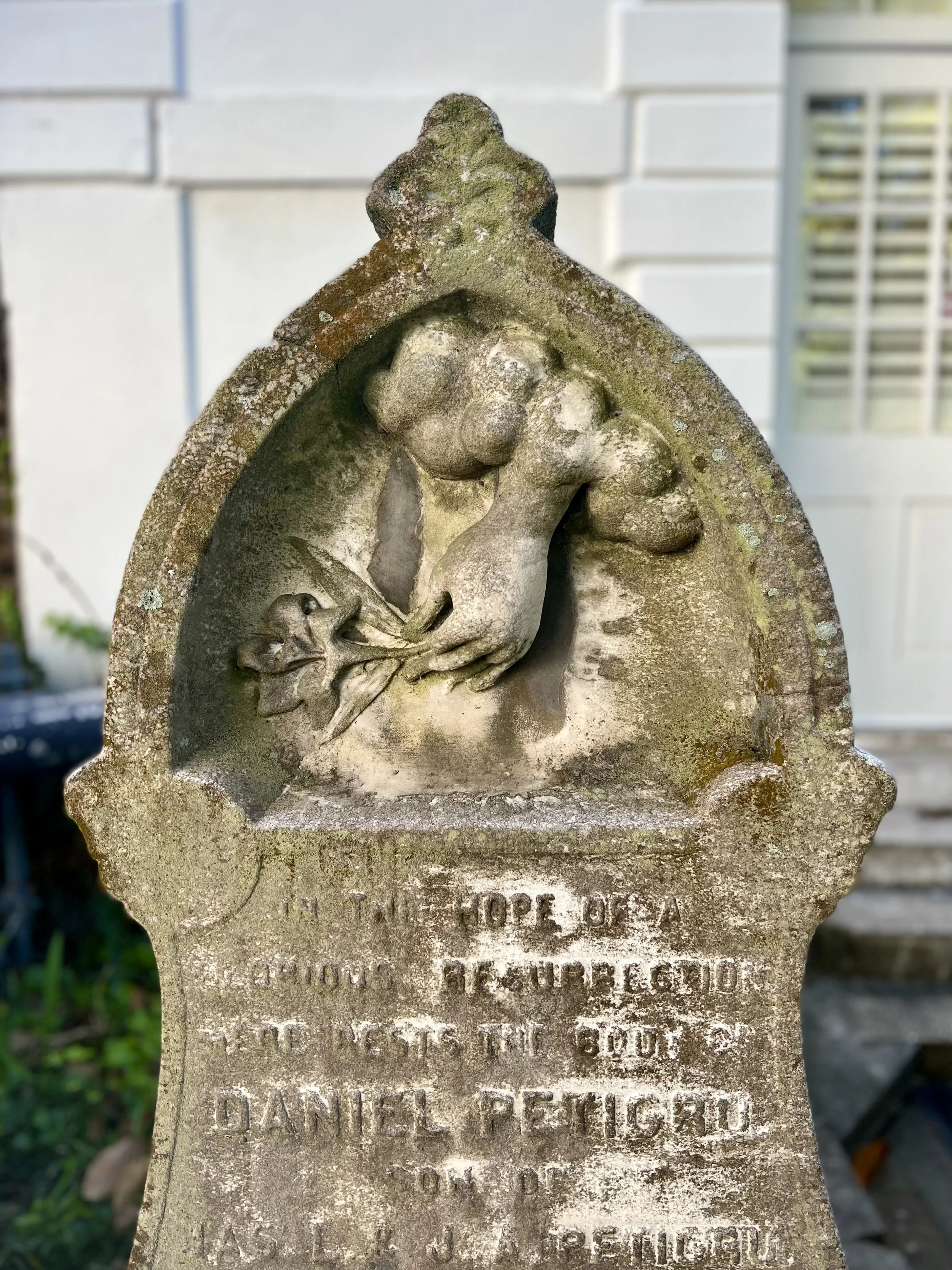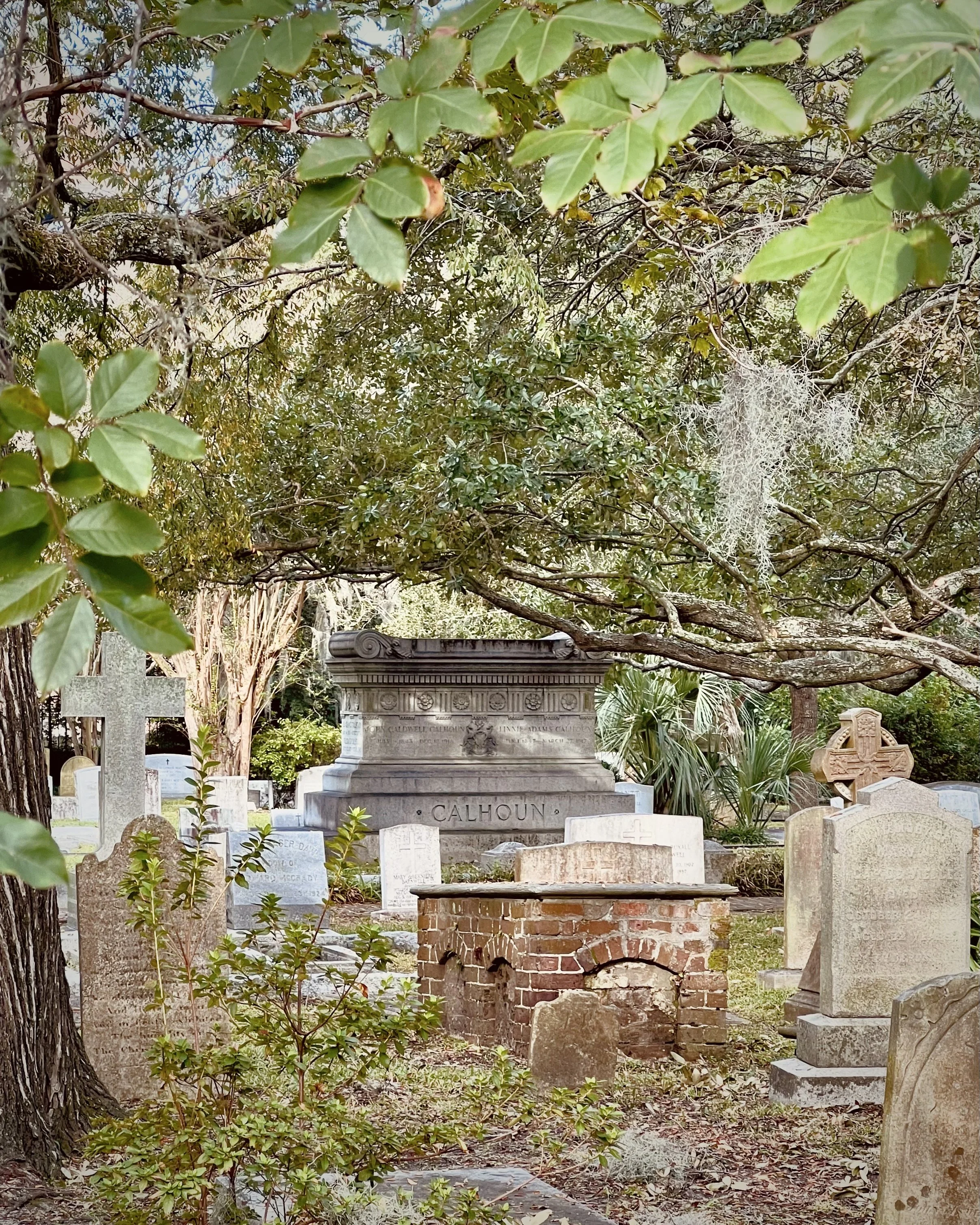Bonus post: Remarkable Charleston Graves
We love to share the stories of some of the most interesting grave markers in Charleston. Here are just a few of our favorites:
Mary Ann Luyten’s Headboard Headstone
As you wander through St. Michael’s Churchyard - where you’ll find buried some of Charleston’s most historically significant figures - you may stumble across an unusual grave marker: a wooden headboard, as from a bed, carved with the name and death date of a Mary Ann Luyten. Why a headboard?
The story goes that young Mary Ann was engaged to a Mr. William Luyten, a cabinetmaker from England who had settled in Charleston. Just days before their wedding, Mary Ann was thrown from her horse and paralyzed. She tried to release William from his promise of marriage, but he insisted that they still marry. He built his new wife a wooden bedframe, where she was bound for the rest of her life. They had nine years together, and shortly before her death at the age of 27, Mary Ann requested that her beautiful cypress headboard be used as her grave marker.
Today, the original headboard is preserved in the Charleston museum and a replica stands in St. Michael’s churchyard. We love seeing an unusual marker and learning its bittersweet story.
The Epitaph of James Louis Petigru
Also located in St. Michael’s churchyard is the grave of James Louis Petigru. If you’ve been on our standard history tour, you may remember this story - we end the tour at his Law Office in St. Michael’s Alley. Petigru was a lawyer and politician, serving as the South Carolina Attorney General from 1822-1830. He was an interesting character: though he did not support abolitionist movements, he was a staunch Unionist, famously stating after Secession in 1860 that “South Carolina is too small for a republic, and too large for an insane asylum.”
Although his politics grew to be quite unpopular in South Carolina, he was greatly respected for his dedication to his work and country and for his poetic forms of expression. Upon his death in Charleston in 1863, city and state officials as well as local Confederate officers - despite strongly disagreeing with him in life - created an impressive tribute to the late Petigru and escorted his coffin to burial in St. Michael’s churchyard. His epitaph is known for it poetic quality and praise of a man of many contradictions:
“Future times will hardly know how great a life
This simple stone commemorates—
The tradition of his Eloquence, his
Wisdom and his Wit may fade:
But he lived for ends more durable than fame,
His Eloquence was the protection of the poor and wronged;
His Learning illuminated the principles of Law—
In the admiration of his Peers,
In the respect of his People,
In the affection of his Family,
His was the highest place;
The just meed
Of his kindness and forbearance
His dignity and simplicity
His brilliant genius and his unwearied industry
Unawed by Opinion,
Unseduced by Flattery,
Undismayed by Disaster,
He confronted Life with antique Courage
And Death with Christian Hope.”
The epitaph was so remarkable that President Woodrow Wilson requested that a transcript of it be wired to him during the Paris Peace Conference for the negotiations ending World War I.
John C. Calhoun’s Moving Grave
The “Great Nullifier,” South Carolina senator John C. Calhoun, died in 1850 while in Washington, DC. His body would not be permitted to simply rest in peace, however; during a time when most who passed away far from home were simply interred in the city they visited - an empty tomb with Calhoun’s name on it actually exists in Washington’s Congressional Cemetery - Calhoun’s remains were protected and transported to Charleston with significant effort.
He was laid to rest in a heavy iron casket, which was transported by train from Washington to Wilmington, North Carolina. From here his remains were shipped aboard the steamer Nina to Charleston, where they were met at Smith’s Wharf with a military escort and a funeral carriage modeled after the one designed for Napoleon. The city was draped in black as his sarcophagus was paraded through Charleston’s streets, and then put on display in City Hall’s Council Chamber.
The following day, Calhoun’s remains were transferred to a temporary vault located in St. Philip’s west cemetery, nicknamed the “stranger’s graveyard” as it was a designated burial ground for those who died while visiting Charleston (again, during this time, it was not at all the norm to simply send bodies home). He stayed in this “temporary” resting place for more than a decade, when his remains were exhumed during the Civil War for fear that they would be desecrated by Union Troops. He was secretly buried in the eastern “friendly graveyard” of St. Philip’s Church, then moved back to his “temporary” vault on the western side after the war.
Since then, as far as we know, his remains have finally been permitted to rest in peace.



